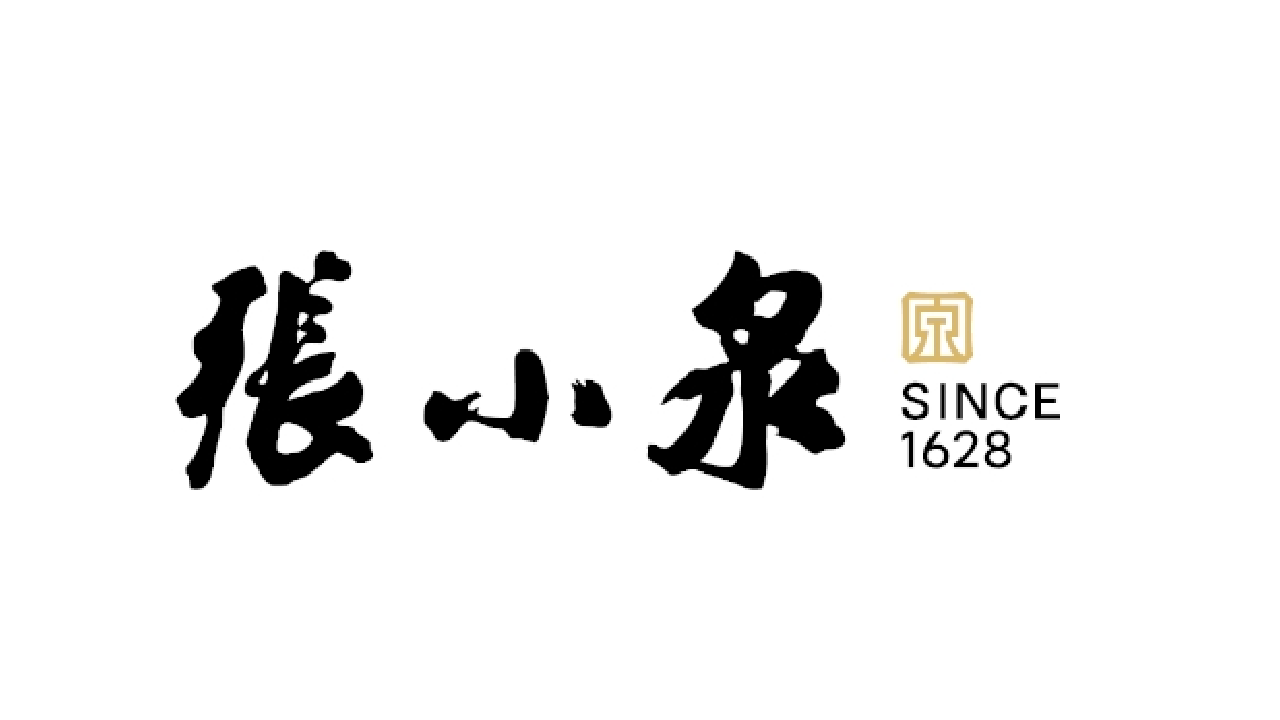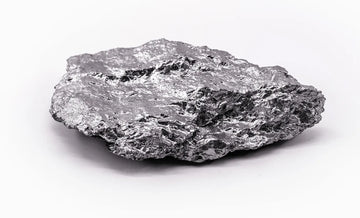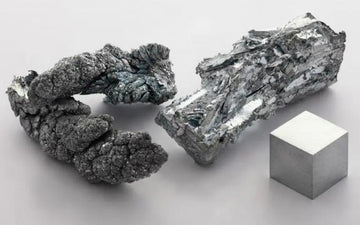In the world of kitchen knives, there's a metal called tungsten that does important work even though we rarely talk about it. It doesn't get as much attention as carbon or chromium, but many of our favorite knives wouldn't perform as well without tungsten. This metal helps make knives harder, more wear-resistant, and capable of maintaining a sharp edge longer in ways that matter when you're using them daily in the kitchen.
What Is Tungsten?
Tungsten is a metal that looks silvery-white, similar to other metals used in knife making. You won't find pure tungsten in your kitchen, but small amounts of it hide inside your knife's steel. It's element number 74 on the periodic table, with an extremely high melting point of 3,422°C (6,192°F) – the highest of any metal.

This metal's remarkable heat resistance and density make it valuable in steel production. In kitchen knife steels, tungsten is used as an alloying element in small amounts, typically between 0.1% and 4%. These small additions make significant differences in the knife's performance.
How Tungsten Makes Knives Better
Significantly Improves Edge Retention
One of tungsten's most important functions in knife steel is improving edge retention. When combined with carbon, tungsten forms extremely hard carbides, creating microscopic particles throughout the steel that resist wear and abrasion.

These tungsten carbides act like tiny barriers that prevent the cutting edge from wearing down quickly, particularly when cutting fibrous or abrasive foods like root vegetables or herbs with silica content.

Increases Hardness
Tungsten contributes to higher hardness levels in kitchen knives. By forming stable carbides and strengthening the steel matrix, tungsten allows blades to achieve and maintain higher HRC (Rockwell Hardness) values.
Steels with proper tungsten content can reach hardness levels of 60-65 HRC or higher while maintaining sufficient toughness, which translates to better cutting performance and less frequent sharpening.
Refines Grain Structure
Tungsten helps create a finer, more uniform grain structure in steel. This finer structure leads to steel that's more consistent in its performance and can take a more polished, sharper edge.

The addition of tungsten also helps maintain this fine-grain structure during heat treatment, contributing to better overall steel quality.
What This Means When You're Using the Knife
Extended Cutting Performance
For everyday kitchen use, tungsten's contribution to edge retention means your knife stays sharper for longer periods, maintaining its cutting efficiency through multiple meal preparations without needing to be resharpened.
This is particularly noticeable when doing high-volume cutting tasks like prepping vegetables for a large gathering or working professionally in a kitchen environment.
Ability to Take a Keener Edge
Knives with appropriate tungsten content tend to accept and hold a more acute edge angle. This means the knife can be sharpened to a finer, more precise cutting edge that slices through ingredients with minimal resistance.

For home cooks, this translates to cleaner cuts, less cell damage to ingredients, and overall more precise knife work.
Sharpening Considerations
The hard tungsten carbides formed in steel make sharpening somewhat more challenging compared to simpler steels. Quality sharpening stones—particularly diamond or ceramic stones—are often needed to effectively sharpen tungsten-rich steels.
While this might mean slightly more effort during sharpening, the trade-off is substantially longer periods between sharpening sessions due to the excellent edge retention.
Common Kitchen Knives with Tungsten
Many premium knife steels contain tungsten for better performance. Let's look at some you might find when shopping for kitchen knives:
Japanese Steel Types
ZDP-189 contains significant tungsten (approximately 0.6%) alongside very high carbon and chromium content. This premium Japanese powder metallurgy steel is known for its exceptional edge retention and hardness (HRC 65-67), making it a favorite for high-end specialty knives.
Blue Steel (Aogami) contains tungsten (0.5-1.5%) as a key alloying element. Available in Blue Steel #1, Blue Steel #2, and Blue Steel Super grades, these steels are prized for their excellent edge retention while maintaining the character of traditional carbon steel. The tungsten content is what distinguishes Blue Steel from White Steel and gives it superior wear resistance.
SG2/R2 contains tungsten in combination with molybdenum, chromium, and vanadium. This powder metallurgy steel achieves excellent edge retention and corrosion resistance, appearing in premium Japanese knives.
HAP40 is a high-speed steel containing substantial tungsten (approximately 5%) along with molybdenum, vanadium, and cobalt. Known for exceptional wear resistance, it's used in premium Japanese knives focused on maximum edge retention.
VG-10 contains a small amount of tungsten, which, along with cobalt and vanadium, contributes to its excellent cutting performance and edge stability. Popular in many Shun knives and other premium Japanese cutlery.
Western Steel Types
CPM S30V includes tungsten alongside vanadium, molybdenum, and chromium. This American-made powder metallurgy steel is increasingly used in premium kitchen knives for its excellent edge retention and corrosion resistance.
Elmax contains tungsten along with chromium, molybdenum, and vanadium. This Swedish powder metallurgy steel offers excellent edge retention and corrosion resistance, finding its way into high-performance kitchen knives.
M390 features tungsten as part of its complex alloy including chromium, molybdenum, and vanadium. This Austrian steel is known for exceptional edge retention and corrosion resistance, becoming popular in premium Western kitchen knives.
K390 contains significant tungsten (approximately 1%) along with vanadium and cobalt. This Austrian high-speed tool steel achieves remarkable wear resistance and is used in specialty kitchen knives designed for extreme edge retention.
Cronidur 30 contains a small amount of tungsten along with nitrogen, molybdenum, and chromium. This specialized German steel offers excellent corrosion resistance with good edge retention, appearing in premium European kitchen knives.
Is Tungsten in Knives Safe?
Tungsten in knife steel is extremely stable and safe for kitchen use. The metal stays locked in the steel's structure and doesn't migrate into food during normal cooking activities.
Tungsten is considered biologically inert, meaning it doesn't react with human tissue. In fact, tungsten is commonly used in medical implants due to its biocompatibility, so its presence in kitchen knives presents no health concerns.
Taking Care of Tungsten-Containing Knives
For best results with tungsten-rich knives:
- Wash by hand with mild soap
- Dry thoroughly after washing
- Store properly in a knife block or on a magnetic rack
- Use appropriate cutting surfaces (wood or plastic boards)
- Avoid cutting frozen foods or bones, as the harder steel may be more brittle
- Sharpen with high-quality ceramic or diamond stones suited to harder steels
Final Thoughts
Tungsten plays an important role in modern kitchen knife steels. Its contributions to edge retention, hardness, and overall cutting performance help create knives that maintain their sharpness through demanding kitchen tasks.
While not as widely discussed as elements like carbon or chromium, tungsten's presence in many premium kitchen knife steels is a testament to its value. Understanding its role can help you make more informed choices when selecting and caring for your kitchen knives.
FAQs
Is tungsten steel good for kitchen knives?
Tungsten isn't typically used as the primary steel type but serves as an important alloying element in many premium kitchen knives. Quality knife steels may contain 0.1-4% tungsten to enhance hardness and edge retention. Steels like Blue Steel (Aogami) and ZDP-189 use tungsten as part of their formula to achieve exceptional cutting performance and durability.
What is the difference between tungsten carbide knives and standard steel knives?
Tungsten carbide knives contain significantly higher amounts of tungsten carbide (typically 85-95%) compared to standard steel knives that may contain only trace amounts of tungsten. Tungsten carbide knives, like those made by Sandrin, achieve exceptional hardness (70+ HRC) and edge retention but are more brittle and require specialized sharpening. Standard steel knives with small tungsten additions offer more balanced performance with conventional maintenance requirements.
Is tungsten good for knife blades?
Yes, tungsten is beneficial for knife blades as an alloying element. It enhances edge retention, increases hardness, and improves wear resistance. Most premium kitchen knife steels contain at least small amounts of tungsten for these benefits, which is why it appears in many high-end steel compositions designed for optimal cutting performance.
Is tungsten better than vanadium in kitchen knives?
Tungsten and vanadium serve different complementary purposes in knife steel rather than being alternatives to each other. Tungsten primarily forms extremely hard carbides that resist wear, while vanadium forms smaller, more numerous carbides that contribute to toughness and corrosion resistance. Many high-quality knife steels contain both elements for their combined benefits. Neither is inherently "better" than the other—they perform different functions in the steel.
What are the disadvantages of tungsten in knife steel?
While tungsten offers several benefits, its main limitations include making sharpening more difficult and potentially reducing toughness when present in higher amounts. The harder carbides formed can be challenging to grind during sharpening, requiring diamond or ceramic stones. Additionally, tungsten-rich steels may be more brittle and prone to chipping if used improperly. Finally, tungsten increases manufacturing costs, which raises knife prices.
How much tungsten do Japanese kitchen knives contain?
Japanese kitchen knives typically contain varying amounts of tungsten depending on the steel type. Blue Steel (Aogami) contains 0.5-1.5% tungsten, with Blue Super having the highest content. ZDP-189 contains approximately 0.6% tungsten. Traditional White Steel (Shirogami) contains virtually no tungsten by design. Powder metallurgy steels like HAP40 may contain up to 4% tungsten for extreme wear resistance.
Does tungsten content affect knife sharpening?
Yes, tungsten significantly affects the sharpening process. Tungsten forms extremely hard carbides that resist abrasion during sharpening, making tungsten-rich steels more challenging to sharpen with conventional stones. Diamond or ceramic sharpening tools are often necessary for effective results. While this requires more effort during sharpening, the trade-off is substantially longer edge retention, which means much less frequent sharpening overall.
Can tungsten in kitchen knives prevent brittleness?
Tungsten alone doesn't prevent brittleness—in fact, in higher concentrations, it can increase brittleness. However, when properly balanced with other elements in well-designed steel compositions, tungsten can contribute to excellent edge stability without excessive brittleness. Modern powder metallurgy techniques have improved how tungsten is distributed within the steel, allowing for better toughness even with higher tungsten content.
Which kitchen tasks benefit most from tungsten in knife steel?
Kitchen tasks involving high-volume cutting benefit most from tungsten in knife steel. Professional prep work, such as processing large quantities of vegetables, herbs, or proteins, takes advantage of the extended edge retention tungsten provides. Additionally, cutting fibrous or abrasive ingredients like leeks, ginger, and pineapple—which can quickly dull ordinary knives—demonstrates the advantage of tungsten-rich steels.
What kitchen knife steel has the highest tungsten content?
Among common kitchen knife steels, HAP40 contains some of the highest tungsten content at approximately 4%. Specialty steels like K390 also contain significant tungsten at around 2%. Beyond kitchen knives, true tungsten carbide blades like those from Sandrin contain 85-95% tungsten carbide, though these are specialty products. Most kitchen knife steels contain between 0.1-1.5% tungsten, as higher amounts must be carefully balanced to maintain proper toughness and manufacturing feasibility.





